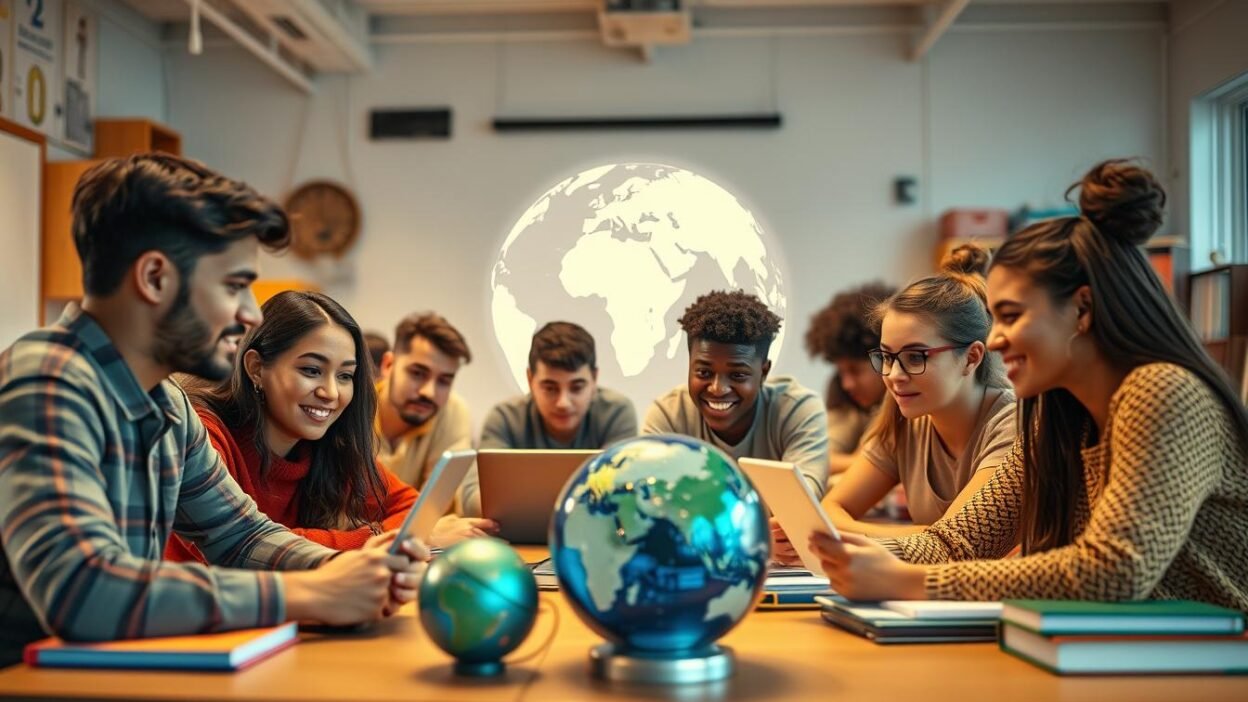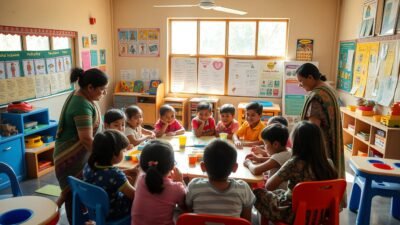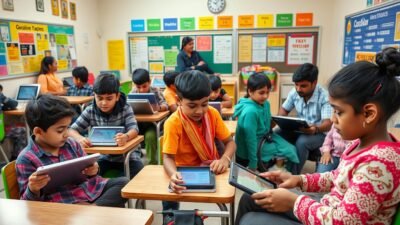Are traditional classrooms becoming outdated in our digital world? Technology is changing everything, and Massive Open Online Courses (MOOCs) are leading this change. These platforms are making learning accessible to millions worldwide, with a big impact in India.
MOOCs are changing how we learn, giving us unlimited access to top-notch educational content. This change is making education more open and available. It’s helping people in big cities and small villages alike, opening doors to new opportunities.
The growth of MOOCs from small experiments to big educational changes is amazing. We’ll look into how these online courses are not just changing education. They’re also changing society in India and around the world.
Preparing for the UGC NET exam can be a daunting task, but with the right resources, candidates can navigate the process effectively. Websites like MyJRF provide a comprehensive platform for aspiring educators, offering specialized guidance for UGC NET Paper 2 preparation and essential tips for acing UGC NET Paper 1. Additionally, understanding the revised syllabus provided by UGC is crucial for a targeted study approach. For official announcements and updates, candidates should regularly visit the UGC NET NTA portal, while the UGC’s job section and the main UGC website are invaluable for post-exam opportunities and academic resources. With these tools, candidates can maximize their preparation and set themselves up for success. Preparing for Paper 1 and UGC NET Paper 2 Education requires a strategic approach with quality resources. UGC NET Education aspirants can access structured video lectures that cover essential concepts comprehensively. For an in-depth understanding, check out teaching aptitude videos and research aptitude guidance to strengthen your foundation. Additionally, higher education system topics and communication skills preparation are crucial for scoring high. Explore logical reasoning tutorials and mathematical reasoning lectures for better problem-solving skills. Enhance your exam strategy with people, development & environment lessons and ICT in education modules. For previous year papers and practice sessions, explore mock test videos and exam strategy tips. Stay ahead in your preparation with teaching methodology insights and subscribe to Educators Plus for expert guidance.
Key Takeaways
- MOOCs offer unlimited access to quality education without entry barriers
- They represent a significant shift in learning accessibility and democratization
- MOOCs are bridging educational gaps across urban and rural India
- The evolution of MOOCs has disrupted traditional educational models
- These platforms are reshaping societal attitudes towards learning and skill acquisition
Introduction to MOOCs and Their Role in Education
Massive Open Online Courses (MOOCs) have changed education. They offer free, web-based learning to anyone. This makes learning available to people all over the world, no matter where they are or how much money they have.
Definition of MOOCs
MOOCs are online courses that anyone can join. They use the internet to reach more people. These courses have video lectures, readings, and tests. Some MOOCs are free, while others charge for a certificate when you finish.
Brief History of MOOCs
The term “MOOC” started in 2008 by George Siemens and Stephen Downes. In 2011, Stanford University’s AI course got over 100,000 students. This showed how big online learning could be.
Types of MOOCs
MOOCs are mainly two types:
| Type | Description | Focus |
|---|---|---|
| cMOOCs | Connectivist MOOCs | Network learning, participant-generated content |
| xMOOCs | Extended MOOCs | Structured content, formal assessments |
cMOOCs focus on freedom, variety, and interaction. They grow through connections between learners. xMOOCs, from universities, offer set content and tests.
MOOCs have changed how we teach and learn. They are key in the future of education and skills.
The Growth of Online Learning Platforms in India
India’s education scene is changing fast. Online learning platforms, like Massive Open Online Courses (MOOCs), are changing how we learn. This change is making old ways of learning less important and opening new paths for students everywhere.
Key Players in the Indian Market
Many platforms lead in India’s online learning world. SWAYAM, started by the Indian government, gives free courses to millions. Other big names include Coursera, edX, and local ones like NPTEL and Unacademy. They offer a wide range of courses, from basic school subjects to advanced professional ones.
Statistics on Online Education Adoption
Online learning in India is growing fast. A survey found that 70% of city students use online learning. In rural areas, 40% more students are taking online courses than last year. The pandemic made schools and colleges use digital learning more.
| Metric | Urban | Rural |
|---|---|---|
| Students using online platforms | 70% | 30% |
| Annual growth in enrollments | 25% | 40% |
| Internet accessibility | 85% | 45% |
Challenges Faced
Online learning in India has its challenges. Not enough internet in rural areas is a big problem. Schools and teachers need better digital tools and training. Some people are also not used to learning online. Solving these issues is key to growing digital education in India.
Advantages of MOOCs for Students
MOOCs are changing education by giving learners worldwide unique benefits. These online platforms are changing how we learn and develop skills in today’s digital world.
Flexibility and Accessibility
MOOCs make learning easy by letting students study anytime, anywhere. This is great for working people, parents, and those in remote areas. They can now learn without interrupting their daily lives.
Cost-Effectiveness
Traditional education can be very expensive. MOOCs offer quality courses at a much lower cost. This makes learning affordable for many who couldn’t afford it before.
Diverse Course Offerings
MOOCs offer a wide range of courses. You can learn everything from computer science to philosophy. This lets students choose courses that match their interests or career goals.
| Aspect | Traditional Education | MOOCs |
|---|---|---|
| Schedule | Fixed class times | Learn at own pace |
| Location | Physical campus | Anywhere with internet |
| Cost | High tuition fees | Free or low-cost options |
| Course Variety | Limited by institution | Wide range of global options |
MOOCs are changing how we design and deliver education. They offer flexible, affordable, and diverse learning experiences. This makes quality education available to people all over the world. As MOOCs grow, they will play a bigger role in shaping the future of learning.
MOOCs vs. Traditional Education Methods
The rise of Massive Open Online Courses (MOOCs) has sparked a debate in academic circles. It’s about their effectiveness compared to traditional education methods. This comparison sheds light on the evolving landscape of teaching and learning in the digital age.
Learning Experiences Reimagined
MOOCs offer a unique learning experience that differs from traditional classrooms. Students engage with content through short videos, interactive quizzes, and online discussions. This format allows for self-paced learning and instant feedback, catering to diverse learning styles.
Traditional education, on the other hand, provides face-to-face interactions and structured schedules. Some learners prefer this.
Accreditation Challenges
Recognition remains a hurdle for MOOCs in the academic world. While some universities now offer credit for MOOC completion, many employers value traditional degrees more highly. But, the landscape is changing.
More institutions are partnering with MOOC platforms to offer accredited online programs.
Career Pathways and Outcomes
MOOCs excel in providing targeted skill development for career advancement. Many professionals use these courses to upskill or switch careers without committing to full-time study. Traditional education typically offers a more complete curriculum.
But, it may not always align closely with rapidly changing industry needs.
| Aspect | MOOCs | Traditional Education |
|---|---|---|
| Flexibility | High | Low |
| Cost | Often free or low-cost | Higher tuition fees |
| Networking | Global online community | Local in-person connections |
| Accreditation | Varies, often less recognized | Generally well-established |
As education evolves, both MOOCs and traditional methods continue to adapt. Each offers unique benefits to learners in India’s diverse academic landscape.
Building Digital Literacy Through MOOCs
MOOCs are key in teaching digital skills and getting people ready for today’s jobs. These online courses cover important digital skills. They help connect what we learn in school with what employers want.
Digital Skills in the Workforce
In today’s job world, knowing how to use technology is a must. Employers want people with tech skills in many fields. MOOCs offer training that matches what employers look for.
| Industry | Digital Skills in Demand | Popular MOOC Courses |
|---|---|---|
| IT | Programming, Data Analysis | Python for Beginners, Big Data Analytics |
| Marketing | Social Media Management, SEO | Digital Marketing Fundamentals, SEO Optimization |
| Finance | Blockchain, Fintech | Introduction to Blockchain, Fintech Innovation |
MOOCs in School Curricula
Schools are adding MOOCs to their lessons to boost digital skills. This lets students learn more subjects and ways of teaching. It gets them ready for the future of learning and work.
Educational Partnerships
MOOC sites team up with schools to make top-notch courses. This mix of school knowledge and online learning makes courses that really teach digital skills.
MOOCs help people learn the tech skills needed for today’s jobs. They bridge the gap between old-school learning and the fast-changing job world.
The Role of Governments and Institutions
Governments and institutions are vital in shaping online education. They help make quality learning resources available to more people. This is important for solving educational problems across India.
Government Initiatives for Online Learning
The Indian government has made big moves to support online learning. SWAYAM, a national MOOC platform, is a standout effort. It offers free courses from school to post-graduate levels, reaching everyone.
| Initiative | Purpose | Impact |
|---|---|---|
| SWAYAM | Provide free online courses | Millions of learners reached |
| National Coordinators | Oversee subject areas | Ensure course quality and relevance |
| Digital India | Improve digital infrastructure | Enhanced connectivity for e-learning |
Collaboration with Global Platforms
Indian schools are teaming up with global education platforms. This partnership brings international knowledge to local students. It makes learning more enriching.
Implementation Challenges
Despite progress, big challenges face MOOCs in India. Infrastructure gaps, mainly in rural areas, slow adoption. Ensuring quality and creating effective policies are ongoing issues.
As the government keeps investing in digital education, MOOCs in India have a bright future. Overcoming these challenges will be key. It will help revolutionize education and make quality learning accessible to all.
Cultural Impact of MOOCs in India
MOOCs are changing India’s education scene. They are making learning more accessible. This shift is opening doors to new ways of getting knowledge.
Evolving Perspectives on Education
How people see education in India is changing fast. MOOCs are showing that learning can happen online, not just in classrooms. They offer flexibility and a wide range of courses, helping people keep up with the world’s fast pace.
Connecting Urban and Rural Learners
MOOCs are closing the gap between city and countryside education. They bring top courses to those in remote areas. This is helping rural areas grow and bringing more opportunities to India.
| Region | MOOC Enrollment Increase (2020-2022) | Top Course Categories |
|---|---|---|
| Urban India | 45% | Technology, Business, Data Science |
| Rural India | 78% | Agriculture, Basic IT, English Language |
Promoting Lifelong Learning
MOOCs are making India a place where learning never stops. People use them to learn new skills, change careers, or keep up with their field. This is making India’s workforce better and more ready for the world.
“MOOCs have opened doors I never knew existed. As a rural student, I now have access to world-class education that was once out of reach.” – Priya Singh, MOOC learner from Madhya Pradesh
The Future of MOOCs in India
Education in India is about to change a lot with MOOCs. The next ten years will see a lot of growth and new ideas in online learning.
A Decade of Growth
The MOOC market is expected to grow fast. It will grow by 32% every year from 2024 to 2034. The value will jump from $13.2 billion to $212.7 billion. This is great news for online learning in India, where MOOCs can help fix old learning problems.
Emerging Trends
MOOCs in India will soon focus on micro-credentials and learning that fits each person. These changes will give learners the education they need in a flexible way. New tech like virtual and augmented reality will make learning more fun and real.
AI’s Role in Education
AI is going to change how MOOCs are made and given. AI can make learning plans, give quick feedback, and help students in many ways. This could make learning better and reach more students in India.
| Aspect | Current State | Future Projection |
|---|---|---|
| Market Value | $13.2 billion (2024) | $212.7 billion (2034) |
| Key Technologies | Basic online platforms | AI, VR, AR integration |
| Learning Approach | Generalized courses | Personalized, adaptive learning |
As MOOCs keep getting better, they will change India’s education. They will offer new ways to solve old problems in education.
Addressing the Digital Divide
The digital divide is a big challenge for MOOCs in India. It stops many from getting education and learning chances. This is because not everyone has access to technology and the internet.
Internet Accessibility Challenges
Places in rural areas and where people are less privileged often have little internet. This makes it hard for them to get online education. The cost of data plans and poor internet speeds add to the problem.
Solutions for Rural and Underprivileged Areas
New ways are being found to close this gap:
- Community learning centers with shared internet access
- Partnerships with telecom companies to provide low-cost data plans for educational purposes
- Offline access to course content through downloadable materials
Importance of Mobile Learning
Mobile devices are helping to make education more accessible. With more people in India having smartphones, mobile-friendly MOOCs are a good answer. They make learning easy on phones and tablets, even in places with slow internet.
| Device | Percentage of MOOC Access |
|---|---|
| Smartphones | 65% |
| Tablets | 20% |
| Computers | 15% |
By tackling these issues, MOOCs can help make education available to everyone in India. This way, learning can reach all parts of society.
Assessment and Evaluation in MOOCs
The rise of Massive Open Online Courses (MOOCs) has changed education. They offer new ways to learn and grow, but also new ways to check how well students are doing.
Traditional vs. Online Assessment Methods
Online education platforms like SWAYAM have changed how we learn. MOOCs let students join virtual classes and learn from anywhere. This means we need new ways to check if students are learning.
| Traditional Assessment | MOOC Assessment |
|---|---|
| In-person exams | Online quizzes and tests |
| Written assignments | Peer-reviewed projects |
| Classroom participation | Forum discussions |
| Group presentations | Virtual team projects |
Student Feedback and Course Improvement
MOOCs use student feedback to make courses better. They look at what learners do to improve the course. This keeps learning fresh and up to date.
Certification and Job Readiness
MOOC certifications are becoming important for jobs. They help students learn new skills and show employers they are ready for work. MOOCs are key for growing your career and learning new things.
The Role of Teachers and Educators
MOOCs have changed the way we teach and learn. They’ve made teachers’ roles different. Now, they need new skills for the digital world.
Adapting to Online Instruction
Teachers now teach online instead of in classrooms. They must learn to use digital tools and create fun online courses. They also need to manage virtual classrooms.
This change requires teachers to keep learning and adapting.
Growth Through Professional Development
MOOCs help teachers grow professionally. They can learn about digital literacy, creating online courses, and managing virtual classrooms. This keeps them up-to-date with new teaching methods and technology.
Connecting in Virtual Spaces
Teaching online is different from teaching in person. Teachers must find ways to engage students online. They need to keep students motivated and build online learning communities.
Being creative and flexible is key to successful online teaching.
| Traditional Teaching | Online Teaching |
|---|---|
| Face-to-face interaction | Virtual communication |
| Fixed class schedules | Flexible learning times |
| Limited reach | Global audience |
Teachers are vital in shaping the future of education. By using new technologies and teaching methods, they can make learning impactful in the digital world.
Success Stories from Indian MOOCs
Indian MOOCs have changed the education scene a lot. They offer quality learning to many students across the country. These courses help improve skills and enhance the curriculum.
Notable Courses and Their Impact
SWAYAM is India’s top MOOC platform. It offers a wide range of courses taught by leading educators. These courses in data science and artificial intelligence are very popular, showing the need for tech skills in India.
Learner Testimonials
Many students say MOOCs helped them advance in their careers. Ravi, a software engineer from Bangalore, got a promotion thanks to a SWAYAM course in machine learning. Priya, a teacher from Jaipur, improved her teaching after an online pedagogy course. This helped her students learn better.
Industry Partnerships Enhancing Learning
MOOCs working with industry leaders has brought great results. Infosys teamed up with NPTEL to offer courses in new technologies. This partnership helps students learn skills needed in the job market. It shows how MOOCs can connect education with industry, preparing India’s workforce for the future.
FAQ
What are MOOCs and how do they differ from traditional online courses?
MOOCs, or Massive Open Online Courses, are big online classes open to everyone. They are different from regular online courses because they let anyone join and offer a full learning experience. This includes video lessons, readings, quizzes, and online discussions, all for little or no cost.
How have MOOCs impacted education in India?
MOOCs have changed education in India for the better. They make quality learning available to many people. This helps close the gap between city and country schools and offers affordable ways to learn new skills. Sites like SWAYAM bring university-level courses to millions of learners in India.
What are the main advantages of taking a MOOC?
MOOCs offer many benefits. You can learn at your own pace and from anywhere with internet. They are cheaper than traditional school and offer a wide range of courses from top schools worldwide. You can also learn new things without going to college.
How do MOOCs compare to traditional classroom education?
MOOCs are more flexible and easy to get to than school. But, they don’t offer the same face-to-face learning and feedback as school. MOOCs use new teaching methods and can teach valuable skills. Yet, getting a degree from a MOOC might be harder to prove than a traditional one.
What role do MOOCs play in building digital literacy?
MOOCs are key in teaching digital skills. They teach learners about online learning and using digital tools for school. This prepares them for the digital world and helps close the digital skills gap.
How are governments and institutions supporting MOOC development in India?
The Indian government supports MOOCs with programs like SWAYAM. Many schools work with global MOOC sites to offer courses. But, there are challenges like building better infrastructure and making sure MOOCs are of high quality.
What is the future outlook for MOOCs in India?
MOOCs in India are set to grow and offer more choices. New trends include micro-credentials and using virtual reality in courses. MOOCs will help meet India’s educational needs and support digital skills.
How are MOOCs addressing the digital divide in India?
MOOCs aim to bridge the digital gap by improving internet in rural areas and making courses mobile-friendly. Some groups offer low-cost devices and offline course materials. But, there’s a lot of work to do to make online learning available to all.
How are students assessed in MOOCs?
MOOCs use quizzes, peer-graded work, projects, and sometimes exams. New methods like adaptive testing and AI are being tried. The big challenge is keeping learning fair and getting recognized by employers and schools.
What is the role of teachers in MOOCs?
Teachers in MOOCs design courses, create content, and lead online classes. They must learn new skills for online teaching. MOOCs also offer teachers a chance to grow professionally and learn new things.





